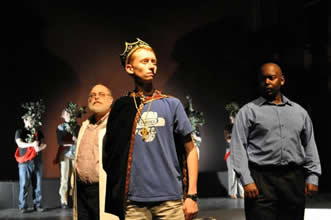On October 29, the North Carolina Symphony performed in Kenan Auditorium on the campus of UNC-Wilmington and put forward a program tacitly unified under a theme of retrospection.
Under the direction of Assistant Conductor Kenneth Raskin, the orchestra opened with Ravel’s “Le Tombeau de Couperin,” the composer’s symphonic version of the piano suite he had completed during World War I. As the title suggests, the work is a both a genuflection toward and an abstract contemplation of the French Baroque and its courtly composers, namely François Couperin and the 18th-century clavecinistes. Understanding the title is an exercise in French symbolism. As musicologist Carolyn Abbate explains (in “Outside Ravel’s Tomb,” published in the Journal of the American Musicological Society, v.52 (1999)), the idea of a tombeau goes beyond musical elegy: “Tombeaux, like their architectural cousin[s], contain the dead.” This work “contains” Couperin by offering a 20th-century representation of traditional French dances, and the fugue and toccata movements found in the original version are notably absent. Marked by clarity of texture that stands in reaction against German romanticism, the Suite reaffirms the continuity of French music, an act of Gallic pride on the part of the Ravel.
I’m generally wary about orchestral transcriptions because passages idiomatic to a particular instrument do not always translate well to a larger ensemble. In this work, however, such concerns become moot; Ravel’s skill with timbre provides even the most insensitive ear with an impression of color tantamount to synesthesia. The orchestra members must be applauded for their attention to one another’s playing, especially in a hall riddled with acoustical challenges. (One eagerly awaits the construction of the new auditorium!) Deserving particular plaudits is Melanie Wilsden, Principal Oboist, whose solos were first-rate. This unfortunately cannot be said of the flutists, who had some difficulty keeping tempo in the fourth movement. Notwithstanding this minor problem, Raskin should be complimented for holding the orchestra to a strict observance, particularly in the second movement, of the Baroque-inspired dotted rhythms, which are dangerously easy to let lapse into a slight “swing.”
Johann Hummel’s Trumpet Concerto, composed in 1803, took second position on the program. The soloist was the NC Symphony’s own Paul Randall, who joined the orchestra in 1988. It was commendable that Randall performed by memory; a performer not tempted to consult a score must instead engage the audience, the result of which is a far more personal mode of musical communication. Randall plays with great sensitivity, demonstrated best during the second movement, though at times he pushed a bit sharp. Nevertheless, this performer gives meaning even to the most rhythmically static notes through his phrasing and control of dynamics; in fact, one would be eager to hear him play a lyrical jazz piece. The only quality of Randall’s playing equal to his expressiveness is his virtuosity, let loose in the final movement. A galloping rondo offered Randall the chance to show off his technique as he nimbly articulated repeated notes at a vigorous pace.
I stated above that the evening had the feel of a backward glance over the history of music. In the “Tombeau,” the association is pre-determined, but in the Trumpet Concerto, we are similarly presented with a composer surveying his influences. Specifically, Hummel tips his hat to his former teacher, Mozart, with whom Hummel had studied and lived for two years during his youth. Indeed, the similarity of the concerto’s second movement to the corresponding Andante of Mozart’s Piano Concerto No. 21 is uncanny; reverence, and not plagiarism, is at work. Surely this must have pleased those particular 19th-century audience members who longed for music in the style of their beloved Mozart. Yet, I wonder if placing this work on the same program as Mozart’s “Jupiter” Symphony might be Classic-era overload, especially given that just five weeks earlier we heard the orchestra perform Haydn’s Symphony No. 104.
Mozart’s Symphony No. 41, you have likely inferred, filled the second half of the concert. Raskin conducted the work by memory, a testament to his talents of memorization and a demonstration of his thorough knowledge of the score. This symphony’s hallowed place in the repertoire makes it familiar to most listeners, who cannot help but eagerly anticipate the finale. The performers similarly reveled in the closing Allegro; their energy increased palpably upon reaching the last movement. In it, we are witness to a wondrous contrapuntal display – a “Tombeau de Bach” (whose works Mozart studied) – that pays tribute to the imitative style of the baroque era. Simultaneously, through the movement’s sheer vivacity, Mozart foreshadows Beethoven’s “heroic” symphonies, at the end of which a listener has gained the feeling of arrival. Tossing motives back and forth, the orchestra partakes in a musical conversation to which each section enthusiastically contributes. It must be mentioned that, at times, the first violins had intonation problems, particularly when handling exposed thematic material. Nevertheless, this Symphony, and the concert in general, was a joyful experience, inspired by compositions that were themselves inspired by music of a previous period.











